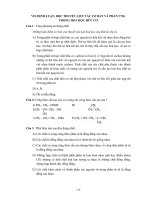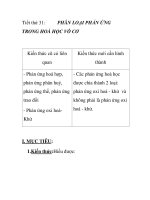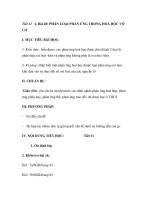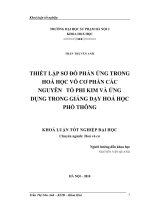Hieu ung trong powerpoint trong Hoa hoc
Bạn đang xem bản rút gọn của tài liệu. Xem và tải ngay bản đầy đủ của tài liệu tại đây (5.38 MB, 47 trang )
PowerPoint: Showing Chemistry
Bigger Than Life
By Ken Costello
Text in this yellow box
are comments about
the animation
techniques used.
Text in the scroll boxes
are what I normally say
when the slide is showing.
Samples of PowerPoint animations from various presentations.
To learn the techniques, run the PowerPoint and
then stop it after each slide to examine the
Custom Animation Window. Bring up the
window by going to the SlideShow pull down
menu at the top of the screen and then choosing
“Custom Animation…”
Click on the animations listed to see its name,
the speed, how it starts, and other properties.
Click the small down arrow to the right of the
animation name to bring up Effect Options
window.
To start the PowerPoint on different slides, either
click the small projector screen icon at the
bottom left or press Shift-F5.
Elements are the new building blocks
Hydrogen
Nitrogen-7
Oxygen-8
Carbon-6
The animation is
done with the Circle
Motion Path for
single electrons and
the Spin effect for
pairs of electrons.
Pairs of electrons are
grouped first.
The Fill effect with
transparency is used
for the spherical
boundaries.
Hydrogen
Hydrogen
Carbon-6
Hydrogen
Hydrogen
Compounds are two
or more elements that
share electrons or
have taken or given
electrons away.
Again, the Circle
Motion path is used
for single electrons,
and the Spin Effect is
use for pairs.
Hydrogen
Hydrogen
Carbon-6
Hydrogen
Hydrogen
Compounds are two
or more elements that
share electrons.
Here the idea of
sharing electrons is
presented with
electrons that are
following custom
motion paths (curved
type)
When electrons are
shared, they don’t
just stay around the
element that first
owned them.
H
H
H
N
C
O
Elements are the new building blocks
O
H
H
C
H
C
H
Let’s build ethanol from
the water and methane.
Note: this isn’t how
ethanol is made, but you
can see the building
block approach.
Straight line motion paths are
used. Most started as “Right”
Paths because that was the
general direction. You can then
move the end to wherever you
want.
O
C
H
Hydrocarbons
Gasoline
H
H
H
C
H
C
H
H
C
H
H
C
H
H
C
H
H
C
H
C
H
H
H
D
i
e
s
e
l
-
1
2
O
i
l
-
2
0
P
l
a
s
t
i
c
1
0
0
0
s
H
H
H
C
H
C
H
H
C
H
H
C
H
H
C
H
H
C
H
C
H
H
H
H
H
H
C
H
C
H
H
C
H
H
C
H
H
C
H
H
C
H
C
H
H
H
O
O
C
O
O
C
C
O
O
Lipids: oils & fats
Hydrocarbons are
simple. They are
built from only
carbon atoms and
hydrogen atoms.
The number of
carbon atoms
determines what
we use them for.
If we use
oxygen atoms,
we can make
lipids.
H
H
H
N
C
O
O
C
C
N
O
H
HH
Ammonia
Acetic acid
Vinegar
C
H
H
H
Let’s look at ammonia
and acetic acid and how
the proton from acetic
acid may go to ammonia
to make ammonium ion
Here I’m using circle motion paths and
custom motion paths (curved type).
H
H
H
N
C
O
Amino acids are building blocks for proteins
O
C
C
N
O
H
C
H
Amino
acid
Glycine
C
H
H
Alanine
S
Glycine is the simplest of the
amino acids. Let’s now make
alanine.
Sulfur is needed for two of the
essential amino acids.
H
N
C
Amino acids are building blocks for proteins
O
C
Glycine
S
H
O
H
C
N
O
H
C
H
H
H
H
H
O
C
N
O
C
H
H
Glycine
Amino acids connect as a
water molecule is
released.
The “Down” motion path was
used for water, then adjusted
by moving the end. Glycine
came in using the “Left” path.
S
H
N
Amino acids are building blocks for proteins
O
C
H
O
C
N
O
H
C
H
By attaching various combinations of the
5 above atoms at this location, living
things make a total of 20 amino acids
that then build all the proteins they need.
This is how nylon is made. A
mixture of Hexamethylene Diamine
(one with green nitrogen atoms)
and Adipic acid (one with red
oxygen atoms). This synthesis
happens spontaneously with water
molecules being released.
Various “Up/Down/Left/Right”
motion paths were used. A spin
effect was used at the end.
Chemistry
changes
the way
you look at
the world.
I found te
picture of
the eyes
but added
various
autoshape
objects.
They were
rotated with
the Spin
Emphasis
effect,
which was
set to
repeat
using the
“Effect
Option”
menu.
When writers try to
explain quantum
chemistry they often
resort to the fantasy
world of Alice in
Wonderland.
This effect was
simple. It used
the Flash bulb
Emphasis effect.
However, I set it
to be very slow at
8 seconds using
the Timing menu
and typing in 8.
Here I do two effects on
the text at the same time.
For example, I’m using
motion paths with either
a fade in zoom or a fade
out. On the original slide,
I followed this animation
with a movie clip from the
Matrix.
If you choose
to stay in this
class…
0.07 nm
This stick figure is made by placing
carbon monoxide molecules onto a
surface using a Scanning Tunneling
Microscope. Each piece was made
with a carbon monoxide molecule,
with atoms only 0.07 nanometers
across.
The “drawing” seems childish until
you realize how small the carbon
dioxide molecules are.
You are familiar with
needlepoint. By placing small
stitches on a surface, you can
make designs.
Imagine you are
going to make this
snowflake design and
each stitch is an
atom.
Here the stitches are much larger
than atoms. To get a sense of the
size of atoms, we must place this
needlepoint pattern far way.
Yes, from this distance we can
realize how small those stitches
are. However, we have to pull
back even farther to have them
the size of atoms.
Now imagine that your hand is
very large and you are trying to
place those stitches (atoms) in
that needlepoint pattern there on
Earth.
Do you now have an
appreciation of how amazing it
is to place atoms into a pattern?
This animation is simple.
Mostly just fade in and
fade out plus some
Grow/shrink effects.









